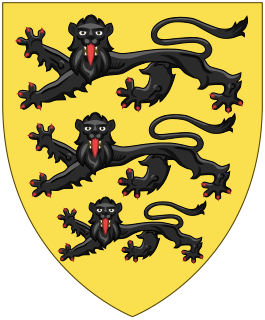
The Hohenstaufen, also called Staufer, was a noble dynasty of unclear origin that rose to rule the Duchy of Swabia from 1079 and to royal rule in the Holy Roman Empire during the Middle Ages from 1138 until 1254. The most prominent kings Frederick I (1155), Henry VI (1191) and Frederick II (1220) ascended the imperial throne and also ruled Italy and Burgundy. The non-contemporary name is derived from a family castle on the Hohenstaufen mountain at the northern fringes of the Swabian Jura near the town of Göppingen. Under Hohenstaufen reign the Holy Roman Empire reached its greatest territorial extent from 1155 to 1268.

Lothair III, sometimes numbered Lothair II and also known as Lothair of Supplinburg, was Holy Roman Emperor from 1133 until his death. He was appointed Duke of Saxony in 1106 and elected King of Germany in 1125 before being crowned emperor in Rome. The son of the Saxon count Gebhard of Supplinburg, his reign was troubled by the constant intriguing of the Hohenstaufens, Duke Frederick II of Swabia and Duke Conrad of Franconia. He died while returning from a successful campaign against the Norman Kingdom of Sicily.
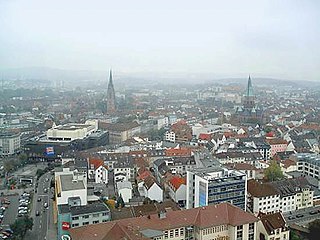
Kaiserslautern is a city in southwest Germany, located in the state of Rhineland-Palatinate at the edge of the Palatinate Forest. The historic centre dates to the 9th century. It is 459 kilometres from Paris, 117 km from Frankfurt am Main, 666 kilometers from Berlin, and 159 km from Luxembourg.

Altenburg is a city in Thuringia, Germany, located 40 kilometres south of Leipzig, 90 kilometres west of Dresden and 100 kilometres east of Erfurt. It is the capital of the Altenburger Land district and part of a polycentric old-industrial textile and metal production region between Gera, Zwickau and Chemnitz with more than 1 million inhabitants, while the city itself has a population of 33,000. Today, the city and its rural county is part of the Central German Metropolitan Region.
Frederick II, called the One-Eyed, was Duke of Swabia from 1105 until his death, the second from the Hohenstaufen dynasty. His younger brother Conrad was elected King of the Romans in 1138.

Gelnhausen is a town, and the capital of the Main-Kinzig-Kreis, in Hesse, Germany. It is located approximately 40 kilometers east of Frankfurt am Main, between the Vogelsberg mountains and the Spessart range at the river Kinzig. It is one of the eleven towns in the district. Gelnhausen has around 22,000 inhabitants.
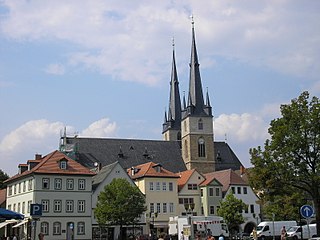
Saalfeld is a town in Germany, capital of the Saalfeld-Rudolstadt district of Thuringia. It is best known internationally as the ancestral seat of the Saxe-Coburg and Gotha branch of the Saxon House of Wettin, which was renamed the House of Windsor during their British reign in 1917.

The Kyffhäuser, sometimes also referred to as Kyffhäusergebirge, is a hill range in Central Germany, shared by Thuringia and Saxony-Anhalt, southeast of the Harz mountains. It reaches its highest point at the Kulpenberg with an elevation of 473.4 metres (1,553 ft). The range is the site of medieval Kyffhausen Castle and the 19th century Kyffhäuser Monument; it has significance in German traditional mythology as the legendary resting place of Emperor Frederick Barbarossa.
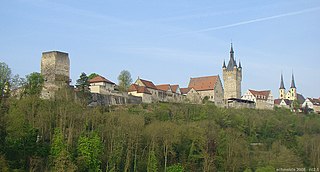
Bad Wimpfen is a historic spa town in the district of Heilbronn in the Baden-Württemberg region of southern Germany. It lies north of the city of Heilbronn, on the river Neckar.

Seligenstadt is a town in the Offenbach district in the Regierungsbezirk of Darmstadt in Hesse, Germany. Seligenstadt is one of Germany's oldest towns and was already of great importance in Carolingian times.
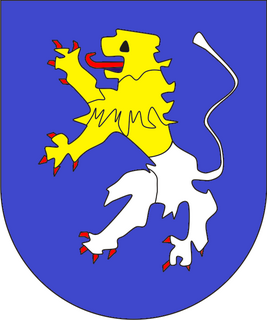
Pleissnerland, Pleissenland or the Imperial Territory of Pleissenland was a Reichsgut of the Holy Roman Empire, which meant that it was directly possessed by the respective elected King of the Romans or Emperor. It was named for the Pleiße River, and was located in what is now the border region between the German states of Thuringia and Saxony south of Leipzig, including the towns of Altenburg, Chemnitz, Zwickau and Leisnig.

The term Kaiserpfalz or Königspfalz refers to a number of castles and palaces across the Holy Roman Empire that served as temporary, secondary seats of power for the Holy Roman Emperor in the Early and High Middle Ages. The term was also used more rarely for a bishop who, as a territorial lord (Landesherr), had to provide the king and his entourage with board and lodging, a duty referred to as Gastungspflicht.

Bad Frankenhausen is a spa town in the German state of Thuringia. It is located at the southern slope of the Kyffhäuser mountain range, on an artificial arm of the Wipper river, a tributary of the Unstrut. Because of the nearby Kyffhäuser monument dedicated to Emperor Frederick Barbarossa, it is nicknamed Barbarossastadt. The municipality includes the villages of Seehausen, Udersleben, Esperstedt and Ichstedt and Ringleben.

Sinzig is a town in the district of Ahrweiler, in Rhineland-Palatinate, Germany. It is situated on the river Rhine, about 5 km south-east of Remagen and 25 km south-east of Bonn, and it has approximately 20,000 inhabitants (2004).
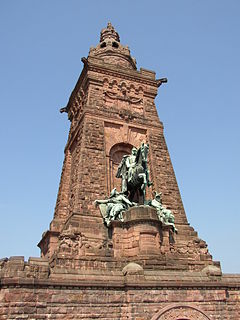
The Kyffhäuser Monument, also known as Barbarossa Monument (Barbarossadenkmal), is an Emperor William monument in the Kyffhäuser mountain range in the German state of Thuringia. It was erected from 1890 to 1896 atop the ruins of the medieval Kyffhausen Castle near Bad Frankenhausen.

Hohenstaufen Castle is a ruined castle in Göppingen in Baden-Württemberg, Germany. The hill castle was built in the 11th century, on a conical hill between the Rems and Fils rivers in what was then the Duchy of Swabia. It was the seat of the Staufer (Hohenstaufen) dynasty, the Dukes of Swabia for the period of 1079–1268, with three Holy Roman Emperors during 1155–1250. The castle was destroyed in the German Peasants' War of 1525.

An imperial castle or Reichsburg was a castle built by order of the Holy Roman Emperor, whose management was entrusted to Reichsministeriales or Burgmannen. It is not possible to identify a clear distinction between imperial castles and the fortified imperial palaces or Pfalzen, because many imperial castles were used by German kings for temporary stays. Many imperial castles were built in regions such as Swabia, Franconia, the Palatinate and the Alsace, where there were a high density of imperial estates (Reichsgüter) during the Hohenstaufen era.

The Imperial Castle of Kyffhausen is a medieval castle ruin, situated in the Kyffhäuser hills in the German state of Thuringia, close to its border with Saxony-Anhalt. Probably founded about 1000, it superseded the nearby imperial palace (Kaiserpfalz) of Tilleda under the rule of the Hohenstaufen emperors during the 12th and 13th centuries. Together with the Kyffhäuser Monument, erected on the castle grounds between 1890 and 1896, it is today a popular tourist destination. The castle is variously known in English as Kyffhausen Castle, Kyffhauser Castle, Kyffhäuser Castle, and Kyffhaueser Castle.

The Imperial Palace at Gelnhausen, in German also called the Kaiserpfalz Gelnhausen, Pfalz Gelnhausen or Barbarossaburg, is located on the Kinzig river – originally on an island –, in the town of Gelnhausen, Hesse, Germany.

Frederick I, nicknamed Barbarossa, was one of the most notable Holy Roman Emperors, who left a considerable political and cultural legacy, especially in Germany and Italy. Thus, he has been the subjects of many studies as well as works of art. Due to his popularity and notoriety, in the 19th and early 20th centuries, he was instrumentalized as a political symbol by many movements and regimes: the Risorgimento, the Wilhelmine government in Germany, and the National Socialist movement. Today, when a tradition-establishing form of commemoration for the emperor is no longer necessary, scholars like Kurt Görich call for neutrality and warn against the instrumentalization of the historical person in the other way. Modern historians generally reject nationalist myths, while portraying the emperor as an influential ruler who suffered many setbacks but often managed to recover. Different studies explore different aspects of his personality, with recent German scholarship emphasizing the emperor's relationship with the chivalrous-courtly culture of the time.






















